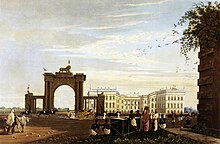James Baillie Fraser
James Baillie Fraser (11 June 1783 – 23 January 1856) was a Scottish travel writer, and artist who illustrated and wrote about Asia Minor, Iran, Kurdistan[1] and India.
William had demonstrated his excellence in Indian languages and customs and he maintained local artists to draw portraits in what is now called the "Company school" style.
Fascinated by the hilly country where they finally met, James began to sketch the scenery of the Himalayan region.
James found that he was not good with human figures and decided to learn from portraits made of Gurkhas by the native artists (especially one named Lalljee) employed by his brother.
He travelled west to Bombay, and then accompanied the East India Company officer Andrew Jukes to Persia, sailing to Bushahr and then on to Tehran, and finally reached London in 1823.
The works by which he attained his literary reputation were accounts of his travels and fictitious tales illustrative of Eastern life.
In both he employed a vigorous and impassioned style which was on the whole wonderfully effective in spite of minor faults in taste and flaws in structure.
[9] Fraser's earliest writings are: Journal of a Tour through Part of the Himala Mountains and to the Sources of the Jumna and the Ganges (1820); A Narrative of a Journey into Khorasan in the Years 1821 and 1822, including some Account of the Countries to the North-East of Persia (1825); and Travels and Adventures in the Persian Provinces on the Southern Banks of the Caspian Sea (1826).
His romances include The Kuzzilbash, a Tale of Khorasan (1828), and its sequel The Persian Adventurer (1830); Allee Neemroo (1842); and The Dark Falcon (1844).
He also wrote An Historical and Descriptive Account of Persia (1834); A Winter's Journey (Tâtar,) from Constantinople to Teheran (1838); Travels in Koordistan, Mesopotamia, etc.


